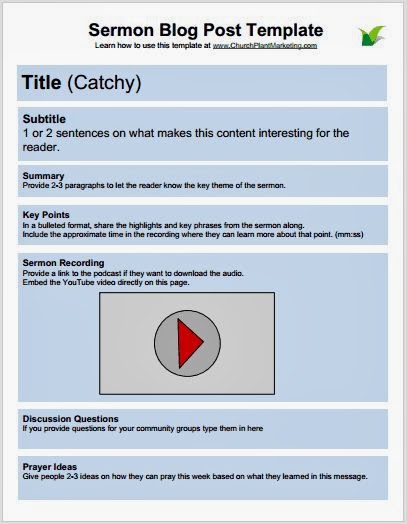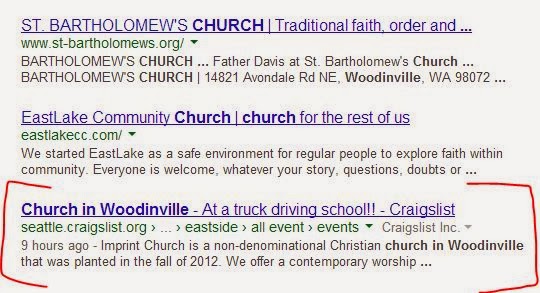Think about how much time you spend every week researching, organizing, and writing your sermon. Most full-grown adults haven't written a term paper since college, but as a church planting pastor you are on the hook to write one every single week!
So, what happens to that amazing resource and all of your hard work come Monday morning? In this article, I am going to explain how to
convert your sermon into an online marketing powerhouse that will drive people to your church website for years to come.
Why the Sermon is Your Best Content Marketing Tool
Converting your sermon into a blog post, video, and podcast is going to require about 2 hours of work every week. Here is why that 2 hours is time well spent.
- SEO Value - Consistently adding good, meaty, and relevant content to your website is a great indicator to the search engines that your church is healthy and should be served up in the search results.
- Members - Your church members know that every week they can find the recording and discussion notes consistently on your website.
- Church Shoppers - When somebody is looking for a church, you want to know if the sermons are any good. (Learn more about what church shoppers need from your website)
- Seekers - There are people all around the world with questions about faith and living a life with Jesus. Why limit your sermon locally?
- Social Channels - You are able to deliver excellent content and build clout through your Facebook, Twitter, Google+, and YouTube channels.
Convert Your Sermon Into Ongoing Marketing Content
This section is all about how to convert your sermon into great content that will help to market your church plant. Every week your goal is to have three new pieces of content from your sermon:
- A Blog Post on your church website
- A Video Sermon loaded to your church YouTube channel
- An Audio Sermon Podcast loaded to your on your Podcast Channel
The principles in this section are based on what we are doing at
Imprint Church in Woodinville WA. Our team consists of our pastor, the writer (that's me), and the Videographer.
Marketing Your Sermon Content
Posting your blog to your website
and your video to YouTube is not the end of the process! To really build
up momentum around your content, you need to seed it in several
additional places.
I would recommend setting up a weekly routine that includes ALL of the following activities.
Facebook
Share a link to the blog post on your
Church Facebook Page
on the Monday after the sermon. The goal is to get your members to
like, comment on, or share this content so their friends can see it.
Twitter
Schedule
2-3 tweets for the week that include one of the highlights from the
sermon, a link back to the blog post, and a #hashtag with the name of
your city or area. The goal here is to connect with local church
shoppers.
Google+
Share the blog post on
Google+ from either a page set up for your church or from your personal
account. Include a #hashtag with your city name. The goal is to send
Google SEO signals so they rank your site higher.
Church Website Links
Make sure people who attend your church can find the content on your website. At Imprint Church, we have a
Sermon Series Page
that links to to the blog posts for all of our past sermons. We also
utilize a Recent Posts feed available from WordPress in the sidebar on
every page.
How to Write Your Sermon Blog Post
Before Church
Our process starts about 2 hours before church on Sunday morning. The pastor sends me his sermon as a Word Doc to read before getting to church. This helps me to start thinking about good ideas for titles and themes in the blog I will write later that day. I print the sermon out, read it, highlight important points, and drop it in a 3-ring binder to bring to church.
During Church
During the sermon, I sit down with my highlighter, pen, cell phone, and sermon notes and start marking the notes up as follows:
- Timings - My cell phone with a stop watch is running throughout the sermon. I mark the mm:ss as he begins every paragraph in the sermon.
- Highlighting - I'm listening for specific ideas that the pastor really emphasizes or that I think people will connect with later.
- Notes - I write reminders for later on content that would make for a great blog title, blog content, tweet, Facebook share, etc. My goal is to not have to read the entire sermon again later on.
Coordinating With Our Videographer
Our volunteer videographer has the job of
- Recording the sermon on camera
- Editing the video
- Producing it as a video file and an audio file
- Uploading the files to our YouTube channel and to our Podcast site.
Immediately after church, I walk back to our video guy with a note saying when to start and stop the recording. We remove any announcements from the beginning and any church-specific talk from the end. Only the sermon is included in the final product.
Later in the day, after having written the sermon blog post, I send our video guy a title and description for YouTube and a separate title and description for the audio Podcast. The YouTube title always end with "Imprint Church in Woodinville". I want Google to see that phrase
Church in Woodinville over and over again in everything I publish.
Structure of the Sermon Blog Post
Let's walk through the elements to include in your sermon blog post. Here is a template of what your weekly blog post can look like:
Title
Make your title catchy. That way, when you post this blog to social media people are enticed to click on it. For example, instead of using "Sermon on Jonah", try a title like "Running from God".
Subtitle
Write 1-2 sentences on why this content is going to be interesting for your reader. This is your hook. Make the subtitle visibly stand out by applying the subheader style or an H1 style.
Summary
Provide 2-3 paragraphs on the key theme of the sermon. Give the whole message away right here! Don't force them to watch the recording if they don't have time.
Key Points
Using bullets, share the highlights and key phrases from the sermon. Include the approximate time in the recording where they can learn more about that specific point. (mm:ss)
Sermon Recording
Provide a link to the podcast if they want to download the audio. Embed the YouTube video directly on this page.
Discussion Questions
If you provide questions for your community groups type them in here. In our church, these are written in advance by the pastor.
Prayer Ideas
Give people 2-3 ideas on how they can pray this week based on what they learned in this message. These prayer ideas are also written by the pastor.
SEO on Sermon Blog Posts
When writing your blog post, don't forget the basics of
Search Engine Optimization. This is important if you want your content to start ranking
on Google and building up the value of your website. SEO on these pages
is fairly simple... just sprinkle in local geographic terms like your
city, neighboring towns, and regional nicknames (eg Seattle Eastside).
Google will know that you are a church over time, but it is vital that
they understand WHERE you are located.
I recommend including two
geographic references per blog post and always using them in an
appropriate context. Here are some examples
- "This week at Imprint Church in Woodinville we learned about..."
- "Here are the discussion questions for our church community groups that meet up around Bothell, Redmond, and Woodinville..."
How Do I Know If This is Working?
There are two free tools that I like to use to track the analytics on our marketing... YouTube and Google Analytics. Sometimes, you just need to see these numbers to affirm that the time you spend on your marketing is worthwhile!
YouTube Analytics
The metrics on YouTube can be quite interesting. As you consistently add videos week after week, the momentum build up pretty fast. The image below is a 30-day report for Imprint Church.
This is after 15 months as a church plant. We are pretty consistent about posting a
sermon trailer video and the recorded sermon every week, so there are about 110 videos on our channel driving these numbers.
Google Analytics
The other impact you'll see with a content marketing plan like this is increased traffic on your website. Most of the people visiting your website will never set foot in your church, but one of the factors Google uses to evaluate your church website for SEO is the amount of traffic you receive. This is an indicator that people find your content interesting and engaging.
Here is another 30-day report for Imprint Church that shows the what kind of traffic we are seeing on our website.
Summary
This was a pretty long post, you get a gold star if you're actually still reading this! Here are the key take-aways.
- Don't throw away that sermon on Monday morning, you spend far too much time writing it.
- Convert the sermon into a long term resource that members of your church, church shoppers, and people with questions about their faith can discover and use.
- Leverage that sermon content as a powerful marketing tool to build your church plant.
If you found this post helpful, please share it with one other church planting pastor. I am happy to answer any questions you have in the comments section below.
















